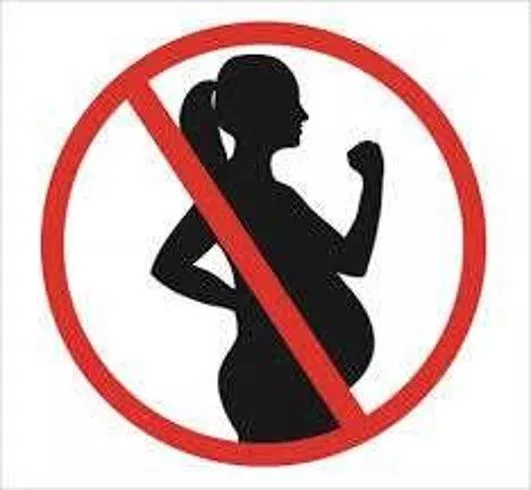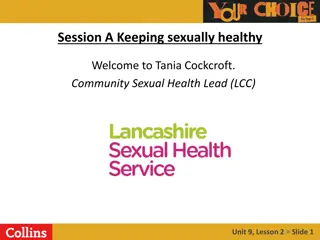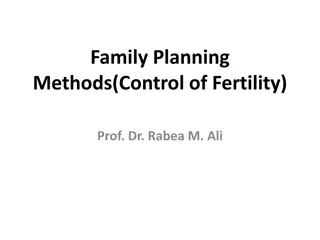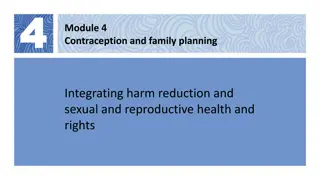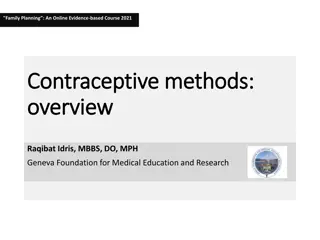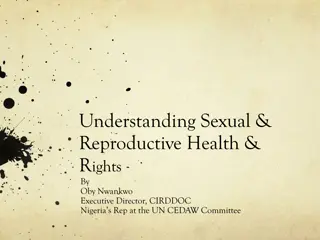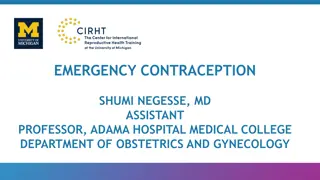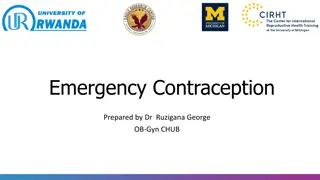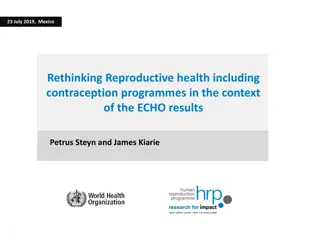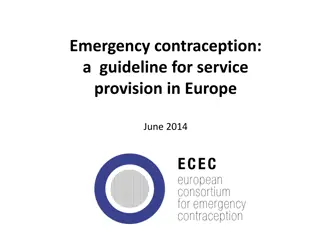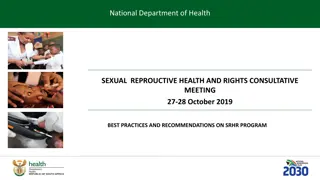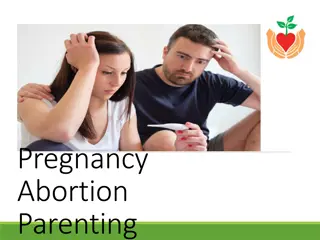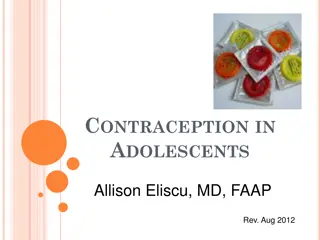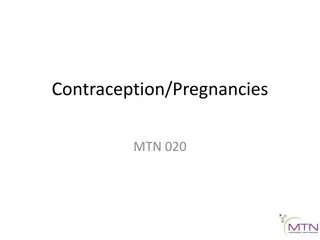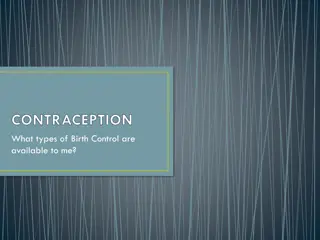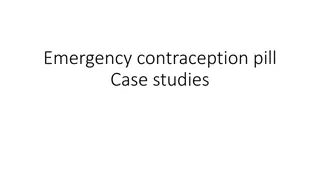Understanding Contraception: Methods, Importance, and Considerations
Contraception refers to methods used to prevent unwanted pregnancies, regulate pregnancy timing, and spacing between pregnancies. It is essential for women's reproductive health and can include barrier methods, hormonal methods, emergency contraception, and intrauterine devices. These methods are safe, effective, reversible, and ideally low-cost, requiring minimal medical supervision. Contraception plays a crucial role in empowering individuals to make informed choices about their reproductive health.
Download Presentation

Please find below an Image/Link to download the presentation.
The content on the website is provided AS IS for your information and personal use only. It may not be sold, licensed, or shared on other websites without obtaining consent from the author. Download presentation by click this link. If you encounter any issues during the download, it is possible that the publisher has removed the file from their server.
E N D
Presentation Transcript
contraception -SANJAY KATRAGADDA 80
Contraception=against conception The preventive methods to help women avoid unwanted pregnancies are called contraceptive methods.
Need for contraception Toavoid unwanted pregnancies Toregulate the timing of pregnancy Toregulate the interval between pregnancy
Ideal contraceptive??? Safe Effective Acceptable Reversible Inexpensive Longlasting Requires little or no medical supervision
t Contraceptive methods
Contraceptivemethods Spacingmethods 1)Barrier Terminalmethods 1)Male fertilisation 2)Femalefertilisation 2)IUDs 3)Hormonal 4)Emergency contraception
Barrier methods Male condoms Female condoms Diaphragm Spermicides
Male condom Most commonly known and used contraceptive Better known in India as NIRODH
spermicides Spermicides are surface active agents which attach themselves to spermatozoa and kill them. Available in various forms like 1. Foams 2. Creams 3. Suppositories 4. Soluble films
Intra uterine devices 1stgeneration: -Inert/non-medicated devices Eg:lippesloop(leftas long as required) 2ndgenration: -Metallic IUDs -Cu-T380A(10 years) -Nova T(5years) -Multiloaddevices 3rdgeneration: -HormonalIUDs -progestasert(2years) -Mirena(LNG-20)(10years)
Contraindication Timing:At the time of menstruation post partum,post pueperal Side effects:1)bleeding 2)pain 3)PID 4)perforation of uterus 5)Ectopic pregnancy
Hormonal contraceptives Combinedpill: -combination of estrogen and progestogen -MALA-N,MALA-D(0.15mg levonorgestrel & 0.03mg ethinyl estradiol) Prgestogen only pill -used in people above 40 years of age & CVS problem Post coital contraception: -Levonorgestrel -Ullipristal -Mifepristone
Adverse effects Cardiovascular effects Carcinogenesis Metabolic effects Liver adenomas Weight gain Breast tenderness
Depot formulations Injectables: DMPA-150 mg IM inj every 3 monthly Subdermal impants: Norplant-6 silastic capsules, each containing 35 mg of levonorgestrol -protection for 5 years
misc Abstinence:only method that is 100% effective Coitus interuptus Rhythm method BBT Cervical mucus Symptothermic method
Terminalmethods Permanent methods One time method -Guidelines Husbands age:25-50 years Wife s age:20-45 2 living children at the time of operation
Male sterilisation Complications: Operative Sperm granules Spontaneous recanalisation Psychological Post op advice: Not sterile till 30 ejaculations Avoid bathing till 24 hours of operation Avoiding heavy weights and wearing a langot
Female sterilisation Laparoscopy Mini lap
Evaluation of contraceptive methods Pearl index: -failures per 100 women years of exposure Pearl index= total accidental pregnancies X1200 total months of exposure Life table analysis:failure rate for each month of use.then the cumulative rate is found out
Family planning in india India was the first country in the world to have launched a National Programme for Family Planning in 1952. Over the decades, the programme has undergone transformation in terms of policy and actual programme implementation and currently being repositioned to not only achieve population stabilization goals but also promote reproductive health and reduce maternal, infant & child mortality and morbidity
Whom to target??? Eligible couple: -Currently married couple where in the wife is in the reproductiveage (15-45years) Unmet need of contraception: -Women with unmet need are those who are fecund and sexually active but are not using any method of contraception, and report not wanting any more children or wanting to delay the next child. -The concept of unmet need points to the gap between women's reproductive intentions and their contraceptivebehaviour -Lackof awarenessand accessibility
UNMET NEED OF CONTRACEPTION Urban Rural Total NFHS 3 INDIA 12.1 13.2 12.9 13.9 MP 13.5 11.6 12.1 12.1 Table 1.1:Data showing the unmet need of contraception in people of INDIA and MP(NFHS 4)
Initiatives Doorstep delivery of contraceptives Incentives for ASHA and people for spacing the pregnancies Incentives for ASHA and people for permanent sterilisation Awareness programs for birth spacing and contraception
Familyplanningmethod Servivceprovider IUCD 380 A and Cu IUCD 375 Trained & certified ANMs, LHVs, SNs and doctors Combined Oral Contraceptive (Mala-N) Trained ASHAs, ANMs, LHVs, SNs and doctors Condoms Trained ASHAs, ANMs, LHVs, SNs and doctors Emergency Contraceptive Pill (Ezy Pill) Trained ASHAs, ANMs, LHVs, SNs and doctors Minilap Trained & certified MBBS doctors & Specialist Doctors Trained & certified MBBS doctors & Specialist Doctors Laparoscopic Sterilization NSV: No Scalpel Vasectomy Trained & certified MBBS doctors & Specialist Doctors



